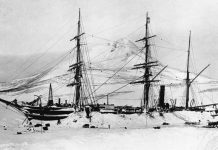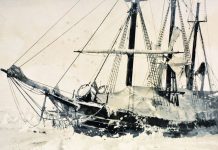In 1912, three Russian polar expeditions went to the northern latitudes at once. Only one of them, having lost its leader G. Ya. Sedov, was able to return home in 1914, the other two (V. A. Rusanova and G. L. Brusilova) disappeared in the polar ice. If the place of the tragic death of Rusanov’s expedition, thanks to a number of finds, can be talked about with a high degree of certainty, then about the fate of Brusilov and those who remained with him on the “St. Anna” 12 people still don’t know anything.
In 1914, when navigator Albanov left the schooner with part of the crew, “St. Anna” was never able to free herself from the ice captivity.
In England, for 20 thousand rubles, Brusilov purchased an old, but still quite strong, schooner, which was built in 1867 specifically for the search for the Franklin expedition that disappeared in the Arctic. The schooner had a triple oak hull and was adapted for sailing in the polar seas.
Obviously, Brusilov was not a superstitious person, otherwise he would have immediately refused to buy this ship, because it was called… “Pandora.”
Recall that the curious Pandora in Greek mythology opened a box filled with disasters, and because of her they spread on earth… The acquired schooner “Pandora” was renamed “Saint Anna” in honor of Baroness A. I. Brusilova, who allocated 90 thousand rubles for the expedition.
Many have read the famous novel by V. Kaverin “Two Captains” or at least seen the films made for this work. The hero of the novel, Sanya Grigoriev, devoted his whole life to finding out the fate of Captain Tatarintsev, and it was the tragic story of the expedition of G. Brusilov that formed the basis of the plot of this most popular book.
The expedition of Georgy Lvovich Brusilov was primarily considered as a commercial enterprise, because its purpose was the St. John’s wort fishery in the seas of the Arctic Ocean and adjacent lands. At first, Brusilov intended to go on an expedition on two ships, it was much safer that way, but high duties on ships bought abroad upset his plans. Even with the purchase of one ship, financial problems arose, only thanks to the support of the press, which presented the expedition as a patriotic enterprise for the development of the Russian North, it was possible to obtain concessions from the Ministry of Finance regarding the duty.
The St. Anna was sailing from St. Petersburg; to get to Alexandrovsk on the Murmansk (now the city of Polyarny), she had to circumnavigate Scandinavia. Intending to get at least some money for the needs of the expedition, we decided to take passengers on board. So Erminia Alexandrovna Zhdanko, a distant relative of G. Brusilov, got on the schooner, to whom doctors recommended treatment with sea air. Together with her friend, she intended to get off in Arkhangelsk and return from there by rail. On July 28, 1912, the schooner put to sea.
It has long been noticed that not only animals, but also some people are able to anticipate trouble. There are usually fewer passengers on planes and ships that are waiting for a sad fate: some refuse to travel at the last moment for no apparent reason, others manage to be late for the fatal flight. The expedition of G. Brusilov, perhaps, broke all records but the number of those who refused to participate in it.
In Trondheim, the expedition mechanic unexpectedly refused to sail further. There was no time to look for another, and the schooner continued its journey. However, this loss was not the last. In Alexandrovsk, it turned out that N. Andreev (an officer on the second watch) and two other small shareholders, including a doctor, who were supposed to join the expedition, refused to participate in it.
In addition, due to illness, navigator Bauman, a senior mechanic and several sailors were discharged from the ship.
Although some of the diseases were not very serious, people, as if anticipating trouble, used any excuse to leave the schooner.
It seemed that the expedition would not take place, but at that moment Brusilova decided to support Erminiy Zhdanko. She said she would not get off the ship and replace the doctor. It should be noted that Erminia graduated from the Sisters of mercy courses. She sent a telegram to her father: “Three participants were lost. I can be useful. I want to go east. I beg you to let me. There will be warm clothes.
It was assumed that the “Saint Anna”, engaged in the fishing of the beast, would pass the Arctic Ocean along the entire northern coast of Russia and finish its journey in Vladivostok’s Golden Horn Bay. Brusilov knew the treacherous nature of the Arctic, so he prudently took a supply of provisions for 1.5 years. Alas, none of the three leaders of the three Russian polar expeditions could even imagine that the years 1912-13 would be abnormally harsh in the Arctic.
Having passed Novaya Zemlya, the “Saint Anna” boldly headed for the Kara Sea, clogged with ice. However, she managed to make her way only to the shores of Yamal, where she froze into the ice 12 km from the coast north of Cape Kharasaway. On October 28, 1912, a large ice field, into which the “Saint Anna” was frozen, was torn off from the solder, and it began to drift slowly to the north.
Brusilov and navigator Albanov decided to keep watches alternately, and Arkhangelsk Pomors were hired instead of the sailors who refused. Thus, the personnel problems were more or less solved, and the “Saint Anna” headed for Novaya Zemlya.
The first wintering in the ice did not frighten anyone, but the summer of 1913 did not bring the long-awaited freedom: only 400 m remained to clear water, but it was not possible to cut through the channel in the ice, and there were no explosives on board. In August, no one doubted that there would be a second wintering, and by the beginning of 1914, the “Saint Anna” was carried out by ice to the north of Franz Josef Land. It became obvious that the drifting ice field had fallen into the current, which at one time carried Nansen’s ship to the west. By analogy with the drift of the “Fram”, it could be expected that the “Saint Anna” would come to clean water somewhere west of Svalbard no earlier than the summer of 1915. There were catastrophically few provisions left, the expedition was threatened with a real famine.
There are thirteen of them left…












































